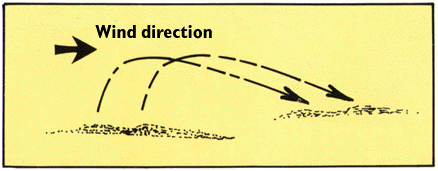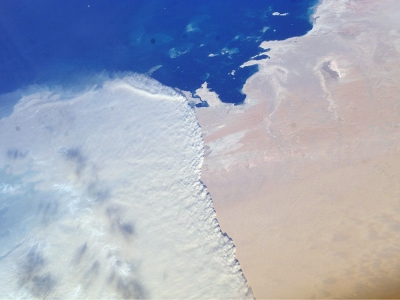Sand transportMuch of our knowledge about sand transport dates back to the 1930s and 1940s when British Brigadier Ralph A. Bagnold conducted experiments while stationed in the desert of North Africa. Sand generally begins to move when the wind achieves a velocity of about 4.5 m/sec. At first, sand exhibits a rolling motion called traction or surface creep. Approximately 20 to 25% of total sand transport during sand storms occurs by traction. As wind speed increases, grains are lifted into the air by wind gusts.
Figure 20.5 Saltating sand grains Once airborne, sand grains travel downwind and then drop back to the surface several centimeters from their point of origin. Finer dust particles are lifted from the surface and suspended in the air at much greater heights than heavier sand grains. With strong winds and turbulence, sand grains can be lifted as high as 2 meters and travel a distance of 10 meters or more. When a settling sand grain impacts the surface, it sends another grain of sand into the air to travel in the downwind direction. Watching this process in action makes sand appear to be bouncing along the surface. We call this process saltation which accounts for 75% to 80% of sand transport over sand dunes. Once saltation begins, transport can continue under somewhat lower wind speeds. Dust storms are primarily composed of fine material that easily reduce visibilities to a few meters and can persist for hours. During a prolonged dry period, extraordinary amounts of valuable top soil was stripped from the Great Plains during the "Dust Bowl" period of the 1930s. Moister conditions returned and the application of soil conservation techniques have greatly reduced the erosive effects of wind. Sand storms are raging systems of blowing, stinging sand traveling a meter or two above the surface.
Figure 20.6 Sandstorm sweeping over the Persian
Gulf state of Qatar racing southward toward southeastern Saudi
Arabia and the United Arab Emirates. A major
upper-level, low-pressure system over southwestern Asia led to a
series of storms that struck the region. Photographed by the crew of
the International Space Station on February 15, 2004. A strange phenomena that has mystified generations is the sound moving sand can make as it is transported across the surface. In approximately 30 places around the world, a sustained hum rings out from this resonating dunes when wind conditions are right. Geoscientist have long wondered what causes "booming dunes". [View "Booming Dunes" from NOVA scienceNow]. |


